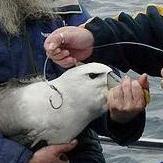 第一屆世界海鳥大會在加拿大維多利亞舉行,吸引來自40個國家關心信天翁、企鵝等海鳥生存的科學家。此次5天的議程7日揭開序幕,是由世界各地26個海鳥專業組織以及社團所發起的。
第一屆世界海鳥大會在加拿大維多利亞舉行,吸引來自40個國家關心信天翁、企鵝等海鳥生存的科學家。此次5天的議程7日揭開序幕,是由世界各地26個海鳥專業組織以及社團所發起的。
「我們希望會議結束時能達成共識,宣布成立一個國際性保護組織,專門處理海鳥監測與保育的議題及合作項目。」國際鳥盟全球海鳥計畫主席克羅素(John Croxall)教授如此表示。
800多名與會者,包括世界上大部份的水鳥專家,齊聚維多利亞會議中心,探討如何幫助海鳥生存,並同步舉辦海鳥影展與藝術展。
總部設於英國劍橋的全球性保育組織「國際鳥盟」表示,信天翁以每5分鐘死亡1隻的速度,成為比其他海鳥更快瀕臨威脅的物種。
22種信天翁之中,有18種已經面臨全球滅絕的危險,而在1994年,才只有7種而已。目前而言,信天翁面臨最大的致死威脅,是產業化延繩釣漁船漁網上的鉤子。
每年延繩釣漁船設置了大約3百萬個鉤子,估計每年殺死了30萬隻海鳥,其中有10萬隻是信天翁。鳥盟警告說,「這麼龐大的死亡數量使信天翁來不及繁衍下一代,把牠們推向真正的滅絕危機。」
但海鳥生存也正面臨漏油、污染、毀滅性魚撈作業以及氣候變化的衝擊。在海島上繁殖的物種也面臨入侵物種的威脅。
為了推動紓緩措施,國際鳥盟和英國鳥會在2006成立了信天翁專案小組;這是全世界第一個致力於教導漁民正確使用紓緩措施、並發展及測試新措施的團隊。
專案小組先設立於最優先保育的國家,也就是海鳥成為意外捕獲(bycatch)最高的國家,即南非與巴西。這些國家與國際鳥盟有緊密聯繫並有在地支持組織。這種方法已經成功。在南非,專案小組跟漁民合作4年之後,先前因為捕魚而死亡的每100隻海鳥,現在有85隻被救起。該小組現在在7個國家執行作業,並計畫將成功經驗擴展到南半球,甚至更遠。
在此次會議裡,代表們將會學習鳥盟和漁民一起工作的實務經驗,鳥盟藉著使用詳實簡單紀錄事實的方法,降低海鳥意外死亡。
另外,一個政府間的保育協定在2004年成立,以解決全世界信天翁和其他較大型海燕的生存需求。這項「信天翁和海燕保育協定」(Agreement on the Conservation of Albatrosses and Petrels )有項資助計畫,用來研訂常用漁法的意外捕獲量,並發展出可行的意外捕獲紓緩措施。
因為,無論是在各國領海或公海地區的漁業管理,都面臨同樣的困難,包括意外捕獲率資料難以取得,而意外捕獲紓緩措施的施行也不易獲得支持。
因此,運用該項資助計畫所收集的資料,可用來協助讓締約成員國用來降低了意外捕漁獲量,並進而發展出專屬經濟海域的行動計畫。這些締約成員國包括阿根廷、澳洲、巴西、智利、法國、厄瓜多爾、紐西蘭、挪威、秘魯、南非、西班牙、英國以及烏拉圭。
此外,美國奧杜邦協會(National Audubon Society)表也提出警訊,海鳥、濱鳥、水鳥與涉水禽等依賴鹹水棲息地的鳥類,在英國石油墨灣漏油事件後正處於最高風險的境地。
奧杜邦警告,從7月初直到未來的4個月,數千萬隻濱鳥、涉水禽及其他遷徙性鳥類,將會歇腳在染有油污的海岸邊、油漬污染的海邊溼地以及油染的海灣水域。
「墨西哥灣就像是美國東部鳥類的中央車站,尤其是密西西比飛航路線。」奧杜邦主席法蘭克‧基爾(Frank Gill)說,「墨西哥灣災害對候鳥的衝擊就好像火車在尖峰時間出軌一樣。不僅僅是影響到整個系統,而且還後患無窮。在海灣清理乾淨之前,要讓健康的鳥類族群能夠抵擋惡劣環境好幾個月甚至好幾年,這將需要持續不斷地緊急應變反應和投資在長期復元。」
Concern for the survival of albatrosses, penguins, and other marine birds has drawn scientists from 40 countries to first World Seabird Conference in Victoria. The five-day event opened Tuesday, sponsored by 26 professional seabird groups and societies from around the world.
"We hope to close the meeting with an announcement that we have formed a new international governing body to address and collaborate on seabird monitoring and conservation," said Professor John Croxall, chairman of BirdLife International's Global Seabird Programme.
More than 800 participants, including most of the world's seabird scientists, are gathered at the Victoria Conference Centre to explore ways to help seabirds survive and enjoy a film festival and seabird art exhibition.
Dying at a rate of around one every five minutes, albatrosses are becoming threatened faster than any other family of birds, according to BirdLife, a global partnership of conservation organizations based in Cambridge, England.
Eighteen of the 22 species of albatross are globally threatened with extinction, an increase from just seven species in 1994. By far the greatest threat faced by albatrosses is death on hooks set by industrial-scale longline fishing vessels.
Every year longliners set about three billion hooks, killing an estimated 300,000 seabirds every year, of which 100,000 are albatrosses. BirdLife warns, "Albatrosses are being killed in such vast numbers that they cannot breed fast enough to keep up, putting them in real danger of extinction."
But seabirds are facing the impact of oil spills as well as pollution, destructive fishing practices and climate change. Island breeding species are suffering from the impact of invasive species.
To promote the mitigation measures BirdLife International and the Royal Society for the Protection of Birds in 2006 formed the Albatross Task Force - the world's first team of dedicated instructors to demonstrate the correct use of mitigation measures to fishermen, and to develop and test new measures.
Teams were initially established in countries with the highest conservation priority in terms of seabird bycatch and those countries which had solid BirdLife links and support structures in place. The initial teams were established in South Africa and Brazil.
This approach has had success. In South Africa four years after the task force began its work with fishermen, for every 100 seabirds previously killed in fisheries, 85 birds now are being saved.
The Albatross Task Force is now active in seven countries and plans to extend this success across the Southern Hemisphere and beyond.
Delegates at the conference will learn how BirdLife has used its practical experience of working with fishermen to develop fact sheets detailing simple and inexpensive measures that can reduce accidental seabird deaths.
An intergovernmental conservation agreement was established in 2004 to address the survival needs of the world's albatrosses and larger petrels.
The Agreement on the Conservation of Albatrosses and Petrels has a grants scheme that invests funds in determining bycatch levels in priority fisheries and in developing promising approaches to bycatch mitigation.
Challenges in both domestic and high seas fisheries include obtaining enough information on bycatch rates and gaining support for implementation of bycatch mitigation measures.
The information gathered as a result of these grants has been used by Parties to the Agreement in their efforts to reduce bycatch and to develop specific plans of action in their Exclusive Economic Zones. Parties now include: Argentina, Australia, Brazil, Chile, France, Ecuador, New Zealand, Norway, Peru, South Africa, Spain, the United Kingdom and Uruguay.
Ocean birds, shorebirds, waterbirds, and waterfowl that rely on saltwater habitat are at highest risk from BP's oil spill in the Gulf of Mexico, according to the National Audubon Society.
Audubon warns that since early July and through the next four months, tens of millions of shorebirds, waterfowl and other migratory birds will land on oiled beaches, in sullied coastal wetlands and on tainted waters of the gulf.
"The Gulf of Mexico is like Grand Central Station for the birds of the eastern United States and especially the Mississippi Flyway," said Audubon President Frank Gill.
"The impact of the Gulf disaster on migrating birds will be like a train derailment during rush hour," said Gill. "Not only will it affect the entire system, but its repercussions will be long-lasting. Enabling healthy bird populations to withstand the months and years before the gulf is clean will require both a continuing emergency response and investments in long-term recovery."
全文及圖片詳見:ENS報導






